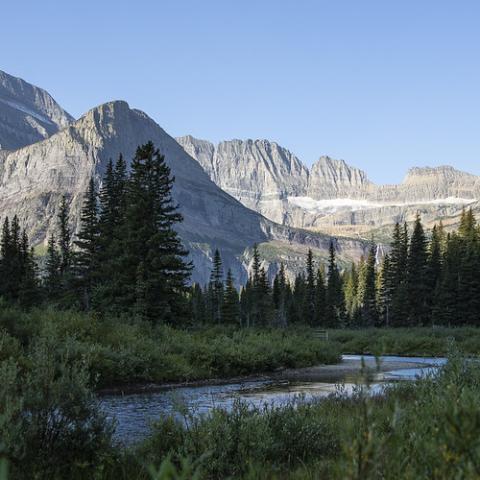
Parks Canada crews are raising disease-resistant whitebark pine seedlings to transplant into Waterton Lakes National Park/Parks Canada
Whitebark pines, a keystone species that can impact spring runoff, nourish grizzly bears when they most need protein, and provide feasts for other wildlife, face a variety of threats, from climate change to a fungal disease. So important are these trees that researchers with Parks Canada are working to raise a veritable disease-resilient forest of whitebark pines.
According to the agency, whitebark pine, a long-lived five-needle species, is threatened throughout its Canadian range by the introduced pathogen white pine blister rust, mountain pine beetles, fire suppression and climate change. It is listed as “endangered” under the Species at Risk Act as the Canadian population is in decline. Some stands in Waterton Lakes National Park just north of Glacier National Park in Montana have an 80 to 90 percent infection rate of invasive white pine blister rust.
Whitebark pine is found in all of Canada's mountain national parks - Waterton Lakes, Banff, Kootenay, Yoho, Mount Revelstoke, Glacier, and Jasper – and Parks Canada teams are actively applying restoration techniques to improve the natural renewal of this species at risk.
Parks Canada protects seed-producing whitebark pine trees that show resistance to the introduced blister rust called ‘plus trees.’ The agency then enhances natural regeneration by planting stock grown from these ‘plus tree’ seeds. Some seedlings are also inoculated with spores of a native fungus called ‘Siberian slippery jack,’ which has a symbiotic relationship with pines and helps the young trees acquire nutrients. When applied to the roots of seedlings prior to planting, the survival and health of those seedlings is greatly improved.
Prescribed fire is also used to restore and improve whitebark pine habitat in sub-alpine regions. These fires replicate natural conditions under which whitebark pine previously evolved and thrived. The process removes competing vegetation and creates nutrient-rich habitat suitable for planting putatively blister rust-resistant whitebark pine seedlings.

Researchers hope disease-resistant whitebark pine seedlings will flourish in the high country of Waterton Lakes National Park/Parks Canada
This fall, Parks Canada planted 1,000 rust-resistant seedlings on Sofa Mountain in Waterton Lakes National Park. Crews planted the seedlings in an area burned by prescribed fire earlier in the season.
Parks Canada’s whitebark pine recovery effort in Waterton Lakes National Park is part of restoration initiatives taking place throughout other national parks and with cooperation from provincial, academic, and international partners. Glacier National Park in Montana has been helping Parks Canada by growing whitebark pine seedlings for the past seven years – up to 6,000 seedlings so far. The collaboration also includes Alberta Agriculture and Forestry, the United States Forest Service, and the British Columbia Forest Service.




 Support Essential Coverage of Essential Places
Support Essential Coverage of Essential Places







Comments
VISIT: Website for The Whitebark Pine Ecosystem Foundation
whitebarkpine.org